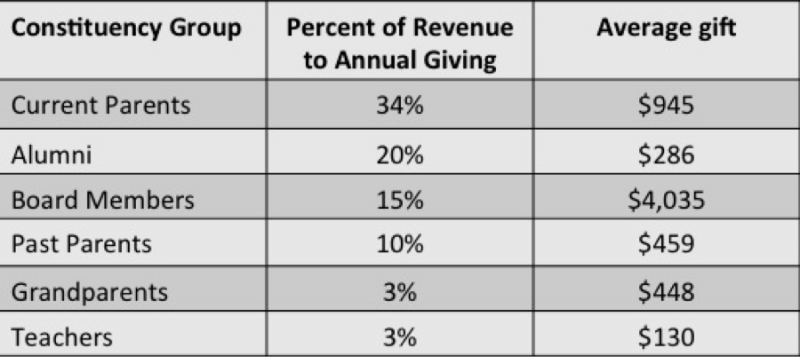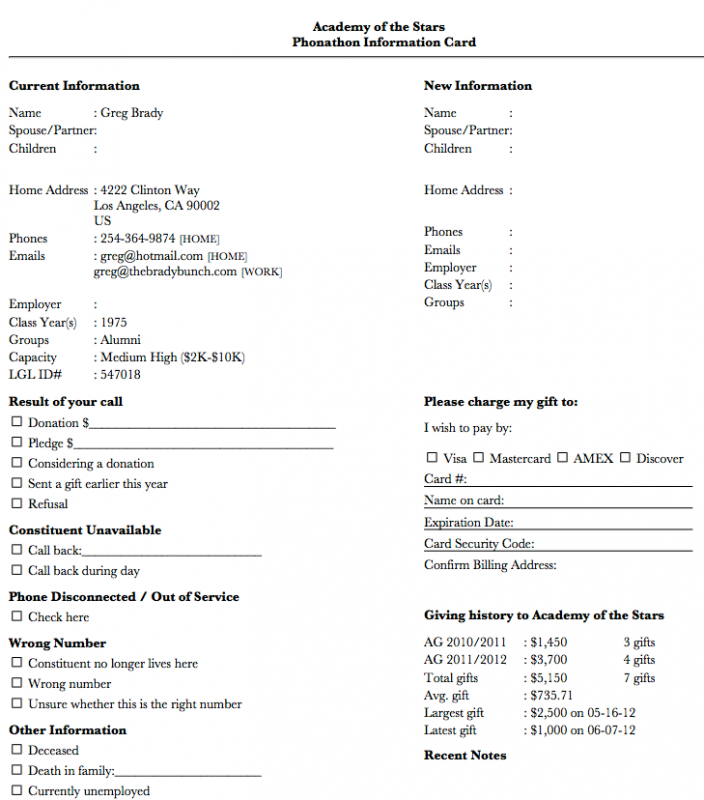Little Green Light is a cloud-based donor management system for fundraisers.
Subscribe to get our latest product updates, best practices and tips to grow your nonprofit.
6 Steps to a Successful Appeal: Part one of a six-part series
The following are keys to building a successful appeal for any non-profit organization or school:
Reaching prospective donors
To best develop a comprehensive list of constituents for an appeal, it is vital to capture data on all who interact with your organization as well as those that you’d like to inform about your work. Start with those who are currently engaged with your organization, perhaps those who use your services, pay tuition or membership fees, or who volunteer or attend your events. These constituents are your organization’s most committed, and therefore your most willing investors.
In educational organizations, alumni are often considered to be the primary donor pool. But as you can see on the chart below from the National Association of Independent Schools Benchmark for Giving, there are no fewer than six sets of constituents that typically contribute to independent schools.
In addition to alumni, parents and grandparents of students can be strong supporters of annual giving programs. Many schools new to annual giving programs avoid asking parents to give a philanthropic gift, believing that they would be unresponsive as they are paying tuition. NAIS’s data proved to the development team at St. Paul Catholic High School, where LGL account manager Timi Paccioretti formerly served as Director of Advancement, that private schools are successful in soliciting parents and securing substantial support. By considering current parents a viable prospect source and expanding their solicitation outreach to include them, St. Paul’s development team tested the strategies that independent schools and colleges have utilized successfully. By doing so, the current parent segment yielded the largest growth in the annual appeal.
Your organization probably has a similarly broad set of constituents to draw upon. They belong to the community your school or organization interacts with and can include event attendees, board members, teachers, grandparents, and others. In other words, for non-profit organizations, members or volunteers shouldn’t be overlooked. For schools, parents (current and past), grandparents, and teachers shouldn’t be overlooked. If you expand your database to include all of your organization’s stakeholders, you will have identified additional constituency groups in your community who are potential donors.
NAIS Benchmarks for Annual Giving

source: National Association of Independent Schools, 2010-11
Figure 1. Look beyond your typical donor populations when building your constituent database. In the case of schools, remember that alumni, current and past parents, grandparents, vendors, teachers, and event attendees are all potential investors.
Gathering the information
It’s a challenge to be effective at collecting data about potential donors. Recognize that there are many within your organization who have contact with your stakeholders and they may have valuable information to assist you in your development efforts. Consider performing an organization-wide information audit, where your team can meet to discuss who keeps what types of information, and develop ways to communicate and capture that valuable insight. One such organization audit in a school setting revealed that the guidance office frequently received transcript requests from graduated students, many of whom were considered ‘lost’ in the development database.
Many possible sources from within your organization structure include admissions, volunteer or membership applications, event attendance and mailing lists, emergency contact forms, and more. Your website is a great portal to collect data as well, as are your organization’s social media sites such as Facebook or LinkedIn. It’s amazing how many sources of information there are in an organization.
| Educational Organization | Nonprofit Organization |
 |  |
Figure 2. Your donors and prospects can come from many different points of interaction in your community.
Data: Your institutional memory
Much of the outreach you do with your stakeholders is dependent on collecting accurate demographic and contact information. Maintaining complete contact information for each of your donors and potential donors is crucial for email blasts, newsletter mailings, and solicitation requests. You need to know how to reach everyone. But, equally important is gathering data about your stakeholders’ involvement with your organization, their interests, and their relationships with others in your organization’s community. It is this information that can help drive your solicitation strategy, and help you to devise appropriate cultivation and stewardship activities for your constituents. For this reason, we encourage you to think of your database as your institutional memory with an importance and value that are far greater than simple contact information.
Your database comprises knowledge about how those prospects and community members are involved in your school or organization. It’s valuable to look at a database and see how John Smith has been interacted with over the last several years because it gives you a much better idea how to continue building a relationship with him so he’ll become an investor in your mission.
Example of a history of interactions with a constituent

Figure 3. What information do you need to know about your prospects? Remember, your database is your institutional memory.
So, what information do you need to collect, and how do you get it? One of the issues many organizations and schools face is that facts, anecdotes, and other key information are kept in the heads of the many hardworking volunteers, advancement professionals, and board members, who have sometimes spent years developing relationships with and knowledge about donors and prospects, When they retire or go on to another job either within or outside your organization, they take that ‘data’ with them; and sometimes the relationship as well. Ideally, you have a comprehensive system to track these attributes, conversations, and interactions, and it would remain accessible to all in your organization.
Data can also be collected and enhanced through events such as phonathons. Figure 4 shows a phonathon form developed through LGL. This is a great way to track the results of a call you’re making and get the data into your database, but it can also help you see exactly what information you have on particular constituents and what information can be updated. You can use this as a way to reach out to your constituency groups and find out more information about them (not to mention gathering pledges for your campaign).
Phonathon Form

Figure 4. Phonathon form.
You need a 360-degree view of your data
Another challenge in collecting data is the need for a secure and useful way to store it, as well as the ability to quickly and easily see and search for information that will help you know your constituents better and be able to relate more personally to them. This can include how a constituent is engaged with your organization, their giving history, which appeals they’ve received, meetings or calls you’ve had with them, events they’ve attended, how they are affiliated with you, and their relationships with your other constituents. Not only is it useful to be able to pull that up at the individual level, you can use it to identify certain segments of constituents. If you can see a 360-degree view of the constituent and use that information to drive your strategy, you’ll be much more effective. Engaging with LGL can help you manage your information and see your constituents. LGL gives you this information in a single page view and also enables you to easily segment your data. This way you can see whole segments of your data, allowing you to plan and target your initiatives.
Screenshot of a constituent detail page from Little Green Light

Figure 5. Constituent record in LGL, where you can see a 360-degree view of each individual constituent.
In addition to contact information in the bottom right corner, you can capture what groups the constituent belongs to and show affiliations through tagging, past giving history, class year, employer information, and contact reports. You can see all the contact that your school or organization has had with the constituent over the years. It’s also easy to collect knowledge that would otherwise have retired or departed with your school’s or organization’s former volunteers and development and advancement professionals.
End of part one
Ready to try LGL? Get your first 30 days free. No credit card required.